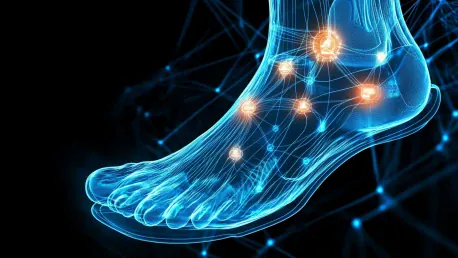The importance of foot health cannot be overstated. Our feet support the entire body, absorbing impact and navigating various surfaces every day. Despite their crucial role, feet are often neglected until problems arise, making proactive foot care essential. Ignoring foot health can lead to significant discomfort and serious medical conditions, underscoring the need for innovative solutions. Fortunately, advancements in wearable technology are revolutionizing how foot care is approached, fostering a shift from reactive treatments to proactive management through continuous monitoring.
Innovative Wearable Technology for Foot Care
Recent advancements in wearable technology, including smart insoles and socks, are set to revolutionize foot health. These devices integrate advanced sensors to predict and prevent injuries before symptoms manifest, signifying a major shift from reactive to proactive foot care management. For instance, smart insoles and socks continuously monitor key foot health indicators such as pressure distribution and inflammation, allowing for timely intervention. The sensors embedded within these innovative wearables are capable of detecting minute deviations from normal patterns, alerting users to potential issues before they develop into significant problems.
Such technology is impactful in daily life, as it offers real-time feedback and facilitates prompt action. Smart insoles, equipped with pressure sensors, can identify improper weight distribution that may lead to calluses or ulcers. These insights enable users to adjust their gait or take necessary precautions to mitigate risks. Similarly, smart socks with temperature sensors can detect early signs of inflammation—a precursor to many foot-related issues. By continuously gathering and analyzing data, these devices empower individuals to take control of their foot health proactively.
Addressing Common Foot Pain and Chronic Conditions
Foot pain is a prevalent issue affecting one in five adults, particularly as they age. This pain can range from minor discomfort to debilitating conditions that impede daily activities. Chronic foot conditions often correlate with diseases such as diabetes, which amplifies the importance of enhanced foot care. Diabetic foot ulcers, for instance, can be particularly alarming, with untreated cases leading to severe infections and even amputations. The significant mortality rate associated with diabetic ulcers highlights the crucial role of early detection and proactive care.
Wearable technology addresses these concerns by providing continuous monitoring, which is vital for early intervention. The ability of smart insoles and socks to detect abnormal pressure or temperature changes allows them to alert users before minor issues escalate into serious conditions. For diabetic patients, this can be a lifesaver. Early detection and intervention can prevent ulcers, reduce the likelihood of infections, and ultimately enhance the quality of life. In this regard, wearable technology serves as a proactive tool in managing chronic foot conditions and preventing complications.
How Wearable Devices Function
Smart insoles and socks operate by monitoring various parameters such as foot pressure, walking patterns, and skin temperature. They utilize sophisticated algorithms to analyze collected data, providing timely warnings about potential foot issues. These devices are designed to be user-friendly and integrate seamlessly into daily routines, ensuring that users receive continuous feedback without any inconvenience. For example, smart insoles are equipped with tiny sensors that track pressure distribution across the feet, identifying improper walking patterns and providing valuable insights.
Such technology is particularly beneficial for older adults and individuals with neurological conditions, as it helps prevent injuries before they occur. By analyzing walking patterns, these insoles can detect anomalies that may not be noticeable to the individual. Early identification of these issues allows users to take preventative measures, reducing the risk of falls and other injuries. The advanced sensors in these devices also capture skin temperature, an essential parameter in detecting inflammation. This feature is especially useful for people with diabetes, who are at higher risk for foot-related complications.
Benefits for Athletes and High-Impact Activities
Athletes, especially those involved in high-impact sports, place significant stress on their feet, increasing the risk of injury. Wearable technology, such as smart insoles, provides immediate feedback on aspects like running techniques, enabling athletes to adjust their form and reduce injury risk. These insoles contain sensors that measure pressure, force, and movement, offering detailed insights into foot mechanics. By analyzing this data, athletes can optimize their performance and prevent injuries resulting from improper techniques.
Studies have shown that athletes who use smart insoles experience fewer injuries and improved performance. The real-time feedback helps in making necessary adjustments promptly, thereby enhancing training outcomes. For instance, runners can use the data to correct their stride, reducing the risk of stress fractures and other repetitive strain injuries. This practical advantage of wearable technology in sports underscores its potential to enhance both safety and performance. Furthermore, coaches and physiotherapists can utilize this data to design personalized training programs tailored to individual needs, maximizing athletic performance.
Advantages for Individuals with Chronic Health Conditions
Wearable technology significantly benefits individuals with chronic conditions such as diabetes. Continuous monitoring through smart devices reduces the risk of severe complications by enabling early detection and intervention. High-risk diabetic patients, for example, have reported substantial reductions in foot ulcer occurrences and amputations due to proactive monitoring. Smart socks designed for these patients continuously track foot temperature and pressure, alerting them to any deviations that might indicate an impending ulcer.
This proactive approach allows for timely medical intervention, preventing the escalation of minor issues into major health concerns. Wearables also help in managing other chronic conditions by monitoring overall foot health and providing insights that guide daily care routines. For instance, these devices can recommend when to rest or alert users to avoid specific activities that could exacerbate their condition. The integration of wearable technology into chronic disease management has proven to enhance patient outcomes by delivering personalized, real-time data that informs better care strategies.
Challenges and Future Innovations
Despite the promising potential of wearable foot technology, several challenges remain. Data privacy is a major concern due to the continuous collection of sensitive health information. Ensuring the security of this data is crucial to prevent unauthorized access and misuse. Additionally, the accuracy of wearable devices is vital to avoid false alarms or missed warnings. Manufacturers must ensure that these devices provide reliable and precise measurements to maintain user trust and effectiveness.
Furthermore, the cost of wearable technology might still be prohibitive for some, limiting its widespread adoption. However, continuous advancements are addressing these challenges. Innovators are developing more affordable, accurate, and user-friendly devices. For example, 3D-printed custom insoles are being explored to enhance comfort and individual fit. Flexible sensors that integrate with smartphones are another promising development, offering seamless tracking and personalized care. These innovations aim to make wearable technology more accessible and practical, paving the way for its broader adoption in foot health monitoring.
The importance of these advancements cannot be overstated. As wearable technology becomes smaller, more affordable, and easier to use, it is poised to transform foot care significantly. Integrating these devices into everyday health routines will enhance proactive care, allowing individuals to monitor their foot health effectively and prevent complications. This progress marks a significant step toward more personalized and efficient healthcare solutions, promising a future where foot health management is seamlessly integrated into daily life.
Conclusion and Potential Impact
The significance of foot health can’t be overemphasized. Our feet bear the entire weight of our bodies, absorbing shock and adapting to different surfaces every single day. Although they play such a crucial role in our overall well-being, feet are often overlooked until issues develop, making preemptive foot care vital. Ignoring the health of our feet can lead to discomfort and even severe medical conditions, highlighting the urgency for innovative solutions. Luckily, advancements in wearable technology are transforming the way we approach foot care. These technologies facilitate a shift from mere reactive treatments to proactive care through continuous monitoring. This continuous monitoring not only aids in identifying potential issues before they become problematic but also offers valuable insights into the overall health, helping individuals make better-informed decisions regarding their foot care routines. As a result, our approach to maintaining foot health is more sophisticated, systematic, and efficient, marking a new era in preventive care.









